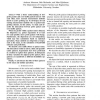Free Online Productivity Tools
i2Speak
i2Symbol
i2OCR
iTex2Img
iWeb2Print
iWeb2Shot
i2Type
iPdf2Split
iPdf2Merge
i2Bopomofo
i2Arabic
i2Style
i2Image
i2PDF
iLatex2Rtf
Sci2ools
CIC
2004
2004
On the Analysis of Packet-Train Probing Schemes
With a better understanding of how probe packets and cross-traffic packets interact with each other, more accurate measurement methods based on active probing can be developed. Several existing measurement methods rely on packet-train probing schemes. In this article, we study and describe the interactions between probe packets and cross-traffic packets. When one packet within a packet train is delayed, the dispersion (i.e. packet separation) of at least two (and possibly more) probe packets will change. Furthermore, the dispersions are not independent, which may bias calculations based on statistical operations. Many methods use dispersion averages, such as the mean, in the calculation of bandwidth estimates and predictions. We describe cross traffic effects on packet trains. The interaction results in mirror, chain and quantification patterns. Experiments have been performed in a testbed to explore these patterns. In histograms of delay variations for adjacent probe packets, these pa...
| Added | 30 Oct 2010 |
| Updated | 30 Oct 2010 |
| Type | Conference |
| Year | 2004 |
| Where | CIC |
| Authors | Andreas Johnsson, Bob Melander, Mats Björkman |
Comments (0)

